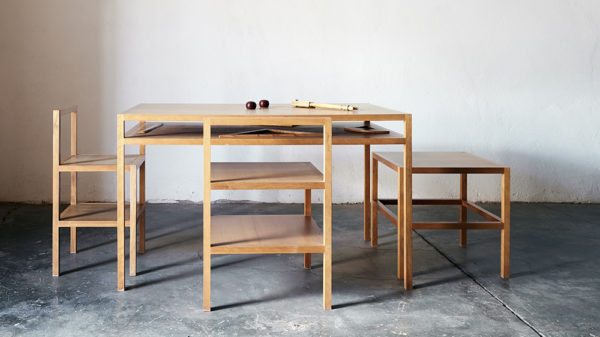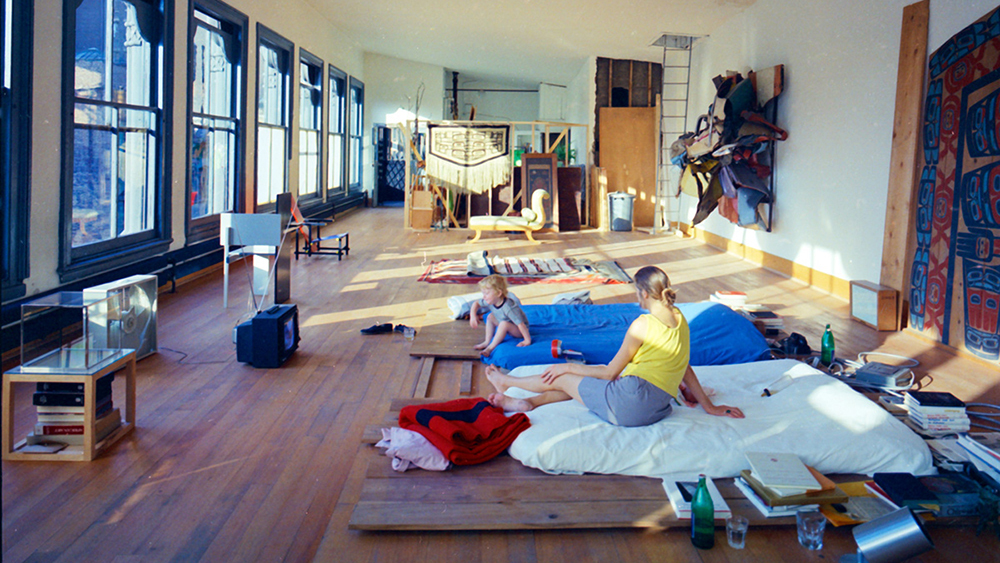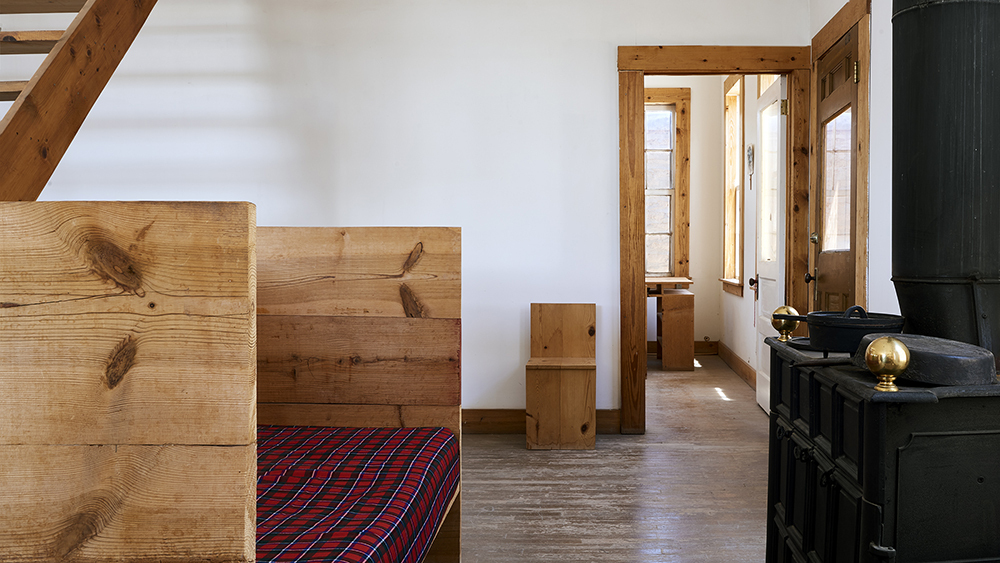Walking around old house at 101 Spring Street in New York’s SoHo is one of the best ways to immerse yourself in the artist’s spare aesthetic. His enormous bedroom, which is so bare-bones that it makes a Japanese ryokan look gaudy, is the highlight. Sitting dead center is the wooden bed, low to the floor, with no headboard. It is the stuff of minimalist dreams but comes with a question mark as big as the statement it makes. Flavin Judd, son of the late, great artist, has the answer. “The bed is plenty functional,” he starts. “But, yes, . . . the pillows will fall off.”
When visitors arrive at the first to be mounted in the US in 30 years—opening at the Museum of Modern Art in New York on March 1—the first thing they encounter won’t be any of his iconic sculptures. Instead, just outside the exhibition entrance, they will see what he created to furnish his homes, erasing any doubt as to his furniture’s importance in the eyes of curators.
Judd, who died in 1994 at the age of 65, railed against the term “minimalism,” but his wall-mounted stacks of galvanized iron boxes, and warehouses full of meticulously lined-up reflective cubes, did a lot with a little. And the artist was never one to surround himself with baroque curlicues or any kind of superfluous decoration. The furniture that he designed for himself is graphic and austere, but as quietly beautiful as it is prosaic. You can see his mind at work with stubborn, muscular practicality: If you can sit on a cube, then there you go . . . that’s a chair. If you can sleep on a platform of wood, that’s a bed. His uncompromising furniture designs—now commercially available—have been as influential as his artwork. “It was important to us to indicate that Judd’s vision extended from sculpture to design,” says Ann Temkin, the chief curator of painting and sculpture at MoMA. “We want our visitors to experience that aspect of his practice firsthand.”
Judd’s furniture has had a major impact on the aesthetics of the 21st century. You can see echoes of it in the linear simplicity of the Apple stores, in Muji’s stacking shelves and in John Pawson’s hard-edged furniture. He made us want to live with less, at a variety of price points. You can buy into the lifestyle by investing in some extraordinarily executed contemporary craft or by sitting on a wooden crate.

Judd’s Block Library desk and chairs in cherry hardwood in Marfa, Texas. Courtesy of the Judd Furniture
Craig Bassam is the cofounder of , the modernist design studio behind the sleek, linear Tuxedo Bench for Geiger/Herman Miller, recently installed throughout the newly expanded MoMA. Bassam has a great appreciation for what Judd achieved with his furniture. “It’s important because it’s a continuation of his art and was made for his personal use,” he explains. “It wasn’t designed as art, but it is like art. It embodies his minimalist sensibility and sensitivity to materials. We find that inspiring—we also design products that are for personal use, so they are meaningful and not what we necessarily think the market wants. You have to love what you design and make.”
The story behind Judd’s furniture is entwined with that of his fascinating, often turbulent life. Necessity, fueled by an inability to find anything that suited his ideal environment, inspired Judd to turn his hand to carpentry to create beds for his family, as well as chairs and tables. Much has been written about his volatile marriage to choreographer Julie Finch when they lived at 101 Spring Street, which he bought in 1968, eons before the arrival of Apple, Prada et al. That same year, the SoHo Artists Association was formed to legalize what many of its members were already doing: living in old industrial lofts. It wasn’t a lifestyle choice per se but more a practicality.
One significant anecdote concerns Judd’s outrage at a brown corduroy sofa Finch acquired from Bloomingdale’s. There would be no whimsical upholstery in the house. Not on his watch. The symbol of the TV-watching bourgeoisie stayed, but their daughter, Rainer, has said the marriage frayed soon after. Judd began making his own furniture, and with five stories of what had been a 19th-century factory to play with, he fashioned a paradigm of stark, chic loft living. Some astute current SoHo loft dwellers, including the fashion designer Phillip Lim, have mixed vintage Judd pieces with contemporary luxe furniture. “I found a set of Judd chairs in a vintage store,” says Lim. “I was amazed and asked them if they had any idea of how important they were. I got them for $1,000 but would have paid $10,000.”
Judd’s way of living still looks as fresh as ever. It represents true modernism as much as it does minimalism: The materials used, whether plywood or refined black walnut, come to the fore visually, and the simple shapes accentuate the volumes of large living spaces. “It was clear to me from when I was small that I was living in a different kind of home from most Americans,” says Flavin Judd, now the artistic director of the Judd Foundation. “People were proud to live in shoeboxes on the Upper West Side, and I felt sorry for them. Don designed what he needed, and he did so consistently. He made his own style.”

Flavin Judd, Julie Finch and an infant Rainer Judd on the 5th floor of 101 Spring Street, 1971-72. Courtesy of the Judd Foundation
Disillusioned by the changes to the neighborhood and the art scene, Judd abandoned SoHo in 1977 for Marfa, a six-and-a-half-hour drive into the desert from Austin, Texas. The big skies, laser-sharp sunlight and remoteness are extraordinary: Marfa was, and still is, the middle of nowhere. The cult filmmaker John Waters created an artwork in 2004 in the form of a mock tourist-board poster: “Take the whole family to Marfa, Texas. ‘The Jonestown of Minimalism.’ See Donald Judd’s Bed! You can’t fly there! It’s a L-O-O-O-O-N-G DRIVE!” Here was the perfect landscape of nothingness for a man who liked to be surrounded by as little as possible. Judd’s departure from New York was abrupt, disappearing with Flavin and Rainer before any custody battle had started with Finch (he subsequently won). Today, much of Marfa (population: 1,714) is given over to both the Judd and the , and it has become an art-world mecca. Chinati is the contemporary art museum that has taken over the sprawling old Fort D. A. Russell military base and that was conceived by Judd as a place where the natural landscape could be married with his large-scale artworks and those by his friends Dan Flavin and John Chamberlain, exhibited both inside and outside. German text, weathered but visible on some of the interior walls, is a reminder that the buildings were used to house POWs during World War II, but today they are full of works by those three men as well as by other artists, including Roni Horn and Ilya Kabakov. Outside, there are pieces by Richard Long, Claes Oldenburg and Coosje van Bruggen.
When Judd moved to Marfa, he continued to create furniture for his family’s new life, collaborating with a closely knit group of fabricators whom he gave exacting specifications. He worked with several carpenters in Marfa—including brothers Celedonio and Alfredo Mediano, and later Ramon Nuñez—and from 1984 he had his metal furniture fabricated in Switzerland, at Lehni AG in Dübendorf. “He had made desk sets for his children,” says Christopher Longfellow, director of operations at Donald Judd Furniture. “He also made a metal desk for gallerist Paula Cooper and other unique designs for friends.”
Slowly, Judd’s furniture evolved into something that was, if far from commercial, then at least accessible to a select group of people outside of his direct family. More than 70 of the furniture designs have been available, made to order, since he first conceived them. In 2017 Donald Judd Furniture began to offer the collection ready-made, with designs from his archive added periodically and all proceeds benefiting the Judd Foundation. It is still produced to the same specifications. “The decision to introduce an online platform, and in-stock designs, was a result of demand,” explains Longfellow. “It allows for the full catalog of Judd’s designs to be seen in all materials. Production is limited to the designs Judd provided, so we are not actually ‘adding’ but researching existing designs made during his lifetime. We are constantly looking at pieces in the archives, for example, with finishes in metal that have not been produced in many years and also frame metal designs. All require a high amount of craftsmanship: There is a precision with the slant of chairs in wood and plywood, and materials like copper and pine demand patience and considerable expertise.”
That expertise makes for expensive pieces. The Single Daybed 32, which boxes the user within five simple wooden panels and is still made in the same woodshop that has been run by carpenter Jeff Jamieson since the 1980s, starts at just over $17,000. For comparison’s sake, a vintage example of the design was sold at auction for $47,500, at Phillips in New York in December 2018. “Simplicity is usually expensive, and the cost to make the furniture is just what it is,” says Rainer. “We are not willing to make bad examples of his furniture just to sell more of it.”

An assortment of Judd’s wood chair designs. Courtesy of Donald Judd Furniture
In 2018, the San Francisco Museum of Modern Art staged , bringing together 30 pieces made during Judd’s lifetime and eight newly fabricated ones, alongside Judd’s drawings. Curator Joseph Becker was inspired to organize the show after discovering just how serious Judd’s interest in modernist furniture—beyond his own—was. “He had a collection of crucial pieces, and his research was encyclopedic,” says Becker. “In recognizing his deference to the achievements of Rietveld, Aalto, Mies van der Rohe, Schindler and others, I was able to understand his approach to designing his own furniture in a way that made it distinct from his art.” Taking inspiration from those earlier designers, Judd fashioned objects for use with the same purity of vision.
For Becker, it is the 20 permutations of Chair 84 that represent “peak Judd.” At first sight it looks like a simple cube with a back panel that extends up from the rear of its core box, but each incorporates an architectural twist. For instance, the Forward Slant Plywood Chair 84’s front panel below the seat is angled inward. It is an iconic design object in an age when the term has become cliché through misuse. As Becker says, “The nuanced shifts in how he treats the volume under the seat reflect his sculptural works, such as the 100 untitled works in mill aluminum on permanent view at Chinati.” The current version of the chair is available for $3,500. When you consider that some of his wall-mounted artworks change hands for millions at auction, the furniture is entry-level Judd, but still rich in resonance. “Judd’s furniture satisfied his desire to explore production, utility and form in an explicitly more hands-on way than his sculpture,” says Becker, refer- ring to the fact that Judd conceived his artworks meticulously but outsourced them for fabrication. “He was also thinking deliberately about how furniture in a room defined the movements and the points of focus within a space, just as his works of art would. It’s clear from the ways he organized his own spaces in Marfa, New York and Switzerland [where he turned the Eichholteren hotel on Lake Lucerne into a private residence] that the entirety of the architecture was considered simultaneously.”
MoMA’s Judd show arrives at an interesting time for art and design, when dealers and practitioners are regularly challenging old definitions. The Pavilion of Art & Design (PAD) fairs in Paris and London, for instance, have put edition furniture and contemporary art on a shared platform. “More clients who would traditionally be ‘art buyers’ in galleries and art fairs are crossing between the two camps,” says Longfellow. Among the most popular makers in this category are the Haas Brothers, whose furniture, though, is rarely used as such. “Most furniture-as-art pieces are impractical or uncomfortable to use,” says Bassam. “Judd’s work is different. It was all about function.” Look at the Seat/Table/Seat Bench 26 (from $10,500), which combines everything it says it does with economy and élan. Or the Shelf Plywood Stool 95 (from $2,900), which you can sit on or use for display or storage.
Numerous contemporary designers have taken inspiration from Judd’s work and philosophy of late. When the School of the Art Institute of Chicago commissioned Navillus Woodworks to create seating for the dean’s office, the local design-build firm supplied walnut modular chairs inspired by Judd’s Library Chair 42. At Salone del Mobile last year, Draga & Aurel showed a series of “Judd” wall lights, with the simplicity of form of the artist they reference but elevated in tinted glass. Rarefied homage follows rarefied homage, but you can also see Judd in more commercial areas, such as Philipp Mainzer’s stark woodwork for e15.

Judd’s Block Daybed and chair. Courtesy of the Judd Foundation
But are Judd’s pieces art, and are PAD and their ilk indicative of a blurring of the lines—or full-on erasure? Flavin Judd says no: “Unless you plan on sitting on your Baselitz painting, there is no inevitable merging of art and design. They do different things.” His father defined the difference adroitly in his 1993 essay “It’s Hard to Find a Good Lamp”: “The art in art is partly the assertion of some- one’s interest regardless of other considerations. A work of art exists as itself; a chair exists as a chair itself. And the idea of a chair isn’t a chair.” Furniture can’t exist solely as a concept, Judd is saying. You have to use it.
Jasper Morrison offers a strikingly different take on the subject. Morrison is responsible for some of the most pared-down designs of the 21st century, a result of research that focuses on the pure function of an object, not unlike Judd’s approach. Still, he admires what he sees as the conceptual artistry running through Judd’s designs. “The interest for me is observing what an artist whose work I admire imagines furniture could be,” Morrison says. “They are not so much furniture as sculptures of furniture existing in a parallel object universe, inspired by the basic constraints of what makes a chair or a table. Nonetheless appealing for not being furniture.” With that, Morrison points to where the tension and visual excitement are in Judd’s designs.
No matter where you fall in that argument, Judd’s tables, chairs and such are utterly uncompromising objects. They are profoundly pleasing to look at, but you’re never going to binge-watch anything while on your Donald Judd daybed, unless it’s festooned with (incongruous) cushions. These pieces sacrifice certain practicalities for a literally rigid aesthetic. They pose questions. They make you think about what furniture actually is, and they transcend style. In their own way, they are masterpieces.




